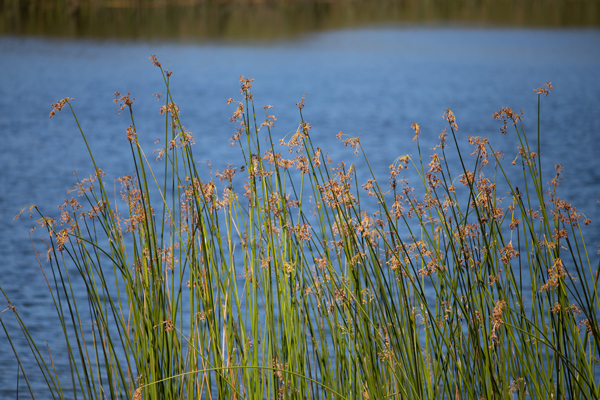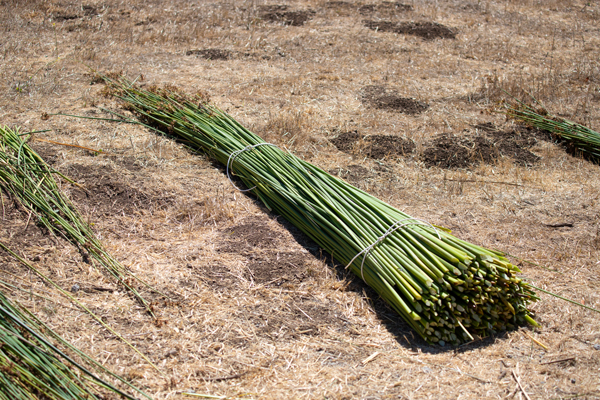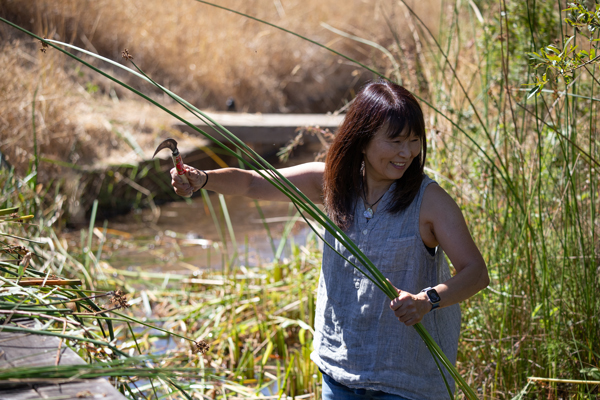Tule Reed Harvest at Black Mountain Ranch

By Matt Dolkas,
Senior Manager, Marketing
September 5, 2024
“Native people in California have been harvesting tule reeds for thousands of years,” Charlie Kennard (pictured above, far right) shared, knee deep in the main pond at Black Mountain Ranch. A small group of local artists and basket weavers led by Charlie had gathered that morning to harvest this wetland plant, material they plan to transform into mats and baskets. “Historical context is key,” Charlie added as he harvested the next small bunch of reeds, “to fully appreciate all we’re weaving together.”
For more than 200 years, Coast Miwok people in Marin County have faced cultural upheaval and oppression. With the invasion of the Spanish in the 18th century, followed by Mexicans and Americans, the Indigenous people of California were brutally persecuted and forcefully removed from their homeland. This dark chapter in history resulted in the near-extinction of many traditional practices and a profound disconnect from ancestral lands.
But the tides are beginning to turn.
Black Mountain Ranch, a 1,350-acre expanse near Point Reyes Station, was protected with an MALT agricultural conservation easement in 2001. Tule reeds, pictured above, are abundant in the ranch’s main pond.
In 2021, the Federated Indians of Graton Rancheria, the federally recognized tribe of Coast Miwok and Southern Pomo groups, entered into a 20-year partnership with the National Parks Service to co-manage the Point Reyes National Seashore. This groundbreaking agreement marks a significant step towards Indigenous stewardship of ancestral lands.
More recently, in the spring of 2023, the Coast Miwok Tribal Council of Marin County purchased 26 acres of their ancestral land near Nicasio, marking the first “land back” effort in Marin County. This acquisition is not just a real estate transaction; it’s a powerful reclamation of heritage and a step towards healing generational trauma.
Building on this momentum, just this month (September 2024), the Federated Indians of Graton Rancheria made another significant stride in reclaiming their ancestral lands. The tribe acquired the 466-acre Dillon Beach Ranch, a prized coastal property in Marin County, through a “land back” conveyance by the Western Rivers Conservancy. This acquisition, one of the largest such conservation deals ever in the North Bay, includes 1.5 miles along the Estero de San Antonio and 1.5 miles of Pacific coastline.
Similar efforts have succeeded across California, including the Wiyot tribe reclaiming an island in Humboldt County and the Esselen tribe purchasing a 1,200-acre ranch near Big Sur. These initiatives are part of a broader, national movement supported by organizations like NDN Collective—an Indigenous-led organization dedicated to building Indigenous power. As NDN Collective states, land back is “not only a necessary way to repair harm done to indigenous people that’s been ongoing for generations, it’s also a way to save the planet.”




Tule reed (Schoenoplectus acutus and S. californicus) are perennial bulrushes native to freshwater marshes across North America. Their long, pithy stems allow them to stand upright in water and grow up to 15 feet tall. “We’ll dry it in the sun for a few days before it’s ready for weaving,” Charlie instructed, “it shrinks quite a bit as it dries, so we have to be patient.”
As a basket weaver and native plant specialist, Charlies’ expertise bridges traditional craftsmanship and ecological knowledge. With decades of experience, he has dedicated his life to learning and teaching the art of basket weaving, focusing on traditional techniques using plants that grow in the Bay Area. His dedication to California’s natural heritage was palpable within minutes of our conversation.
Alongside Charlie that day was Japanese artist Rimiko Berreman (pictured above), whose work seamlessly blends traditional crafts with contemporary art practices. Rimiko’s art is deeply influenced by her Japanese heritage and her connection with California’s landscape, creating a unique fusion of cultural identity. For Rimiko, her work is as much about bringing people together as it is about creating functional art.
Rimiko and Charlie have partnered on many community art projects with Native people, including in the making of tule boats at the California Academy of Sciences, the Bay Model in Sausalito, and the Oakland Museum. But with each new boat, the duo is building more than just watercrafts; they have created a space where cultural preservation, environmental conservation, and contemporary art intersect—weaving more than simple reeds.
Standing on the banks of the pond at Black Mountain Ranch that morning, there was a profound sense of community and connection to this landscape. There is a momentum building around the Indigenous community, a reconnection to this ancestral homeland that goes beyond mere nostalgia. It’s a living, breathing resurgence of culture and tradition that holds promise for a more inclusive and sustainable future.
The Marin Agricultural Land Trust (MALT) acknowledges that we work in the unceded ancestral lands of the Coast Miwok people of present-day Marin County. We recognize the centuries of attempted erasure, displacement, and genocide these communities have endured and that many inequities persist to this day. We honor with gratitude the land itself and celebrate the ongoing relationship with the Coast Miwok people and their traditional territories. As we move forward, MALT is committed to supporting Indigenous land stewardship practices and collaborating with tribal communities to ensure a more equitable and sustainable future for all who call this land home.